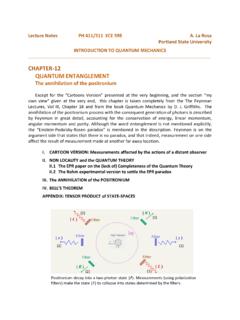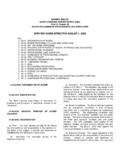Transcription of Curriculum Development Judith Howard Department of ...
1 1 Curriculum Development by Judith Howard Center for the Advancement of Teaching and Learning Elon University Curriculum Development Judith Howard Department of Education Elon University Summer 2007 Let s begin with two foundational works on Curriculum , one by Ralph Tyler (1949) and the other by Jerome Bruner (1960). These provide a good beginning, not only because they were among the first books on Curriculum to be published but because the ideas they contain have been among the most enduring. Indeed, they continue to provide the foundation for our most current thinking in Curriculum Development . Foundations In 1959, at Woods Hole on Cape Cod, a group of 35 scientists, scholars and educators met with the purpose of discussing how to improve science education, to examine the fundamental processes involved in imparting to students a sense of the substance and method of science (Bruner, 1960, p.)
2 Xvii). The meeting was sponsored by the National Academy of Sciences and over the course of the ten day meeting, several important themes emerged that were to have major implications not only for science education, but for education in general. Jerome Bruner s book, The Process of Education, was written to provide an account of the major themes and conclusions that emerged from that conference. While the entire book is worth reading (and re-reading), the chapter on the importance of structure speaks most directly to the Development of Curriculum . The theme of structure as it developed at the Woods Hole conference refers to the importance of presenting the basic structures of the disciplines as the focal points of curricula.
3 Basic structures consist of essential concepts, such as supply and demand in economics or conflict in history or energy in physics, and the relationships among them. Such concepts, when understood, enable students to understand many of the phenomena in that discipline and similar phenomena that may be encountered elsewhere. As Bruner wrote, Learning should not only take us somewhere; it should allow us later to go further more more fundamental or basic is the idea, the greater will be its breadth of applicability to new problems (pp 17-18). Bruner advocated that these fundamental ideas, once identified, should be constantly revisited and reexamined so that understanding deepens over time.
4 This notion of revisiting and reexamining fundamental ideas over time is what has become known as a spiral Curriculum . As time goes by, students return again and again to the basic concepts, building on them, making them more complex, and understanding them more fully. 2 Curriculum Development by Judith Howard Center for the Advancement of Teaching and Learning Elon University A decade before the conference that Jerome Bruner writes about, Ralph Tyler (1949) published his classic text on Curriculum Development . It was organized around four questions: 1. What educational purposes should the school seek to attain?
5 2. How can learning experiences that are likely to be useful in attaining these objectives be selected? 3. How can learning experiences be organized for effective instruction? 4. How can the effectiveness of learning experiences be evaluated? This short volume, written to help educational institutions engage in Curriculum building, called for the application of four corresponding principles in the Development of any Curriculum : defining goals, establishing corresponding learning experiences, organizing learning experiences to have a cumulative effect, and evaluating outcomes. Tyler s principles were the accepted approach to Curriculum Development for almost 30 years, and they guide the essential questions of Curriculum Development today, though they now are applied to newer ideas and considerations that extend or reinterpret his principles.
6 Curriculum Theory and Philosophy A (Very) Brief Overview Probably the biggest objection to Tyler s approach, and the cause of its demise in the 1970 s, was its perceived mechanistic orientation to Curriculum . As the theory was implemented in the 1950 s and 60 s, behavioral objectives provided the underpinning of its design, and the success or failure of the Curriculum was based on pre-defined changes in student behavior. The assumption was that student outcomes at least those that matter could and should be measured. The result was that in order to measure the behaviors, tasks were broken down into smaller and smaller parts, resulting in tasks that lost their authenticity or meaningfulness.
7 Tyler was a product of his time, and his ideas were written and interpreted in light of current educational perspective, which was behavioral in nature. His theory of Curriculum Development was simple, logical, and rational, but it fell out of favor as educators began to view learning experiences more holistically and assess outcomes that are not so easily measured. In response to the Curriculum approach advocated by Tyler, often called the product approach, came what is known as the process approach. This approach is most associated with the work of Lawrence Stenhouse (1974), who advocated principles for selecting content, developing teaching strategies, sequencing learning experiences, and assessing student strengths and weaknesses with an emphasis on empiricism.
8 A process Curriculum was designed to be not an outline to be followed but a proposal to be tested. Gone were the behavioral objectives and tight hierarchical learning tasks. The process approach to Curriculum Development was extended after Stenhouse originally laid it out, morphing into the praxis approach, which added the element of commitment to Curriculum Development . This approach advocates a shared idea of the common good and the goal of informed and committed action to the model of Curriculum Development . Even more recently there has been an emphasis on the context of Curriculum and the notion of Curriculum as a social 3 Curriculum Development by Judith Howard Center for the Advancement of Teaching and Learning Elon University process in which personal interactions within the learning environment take on considerable significance.
9 [For more information on Curriculum as product, process, and praxis, see the article by Smith (2000) on the following website: ] Last, it should be mentioned that developmental theorists continue to have a strong influence on how Curriculum should be structured. Wildman (2007), for example, advocates Curriculum built around what is known about Development and the Vygotskian concept of scaffolding, or what Wildman calls assisted performance. Examples of Recent Thinking in Higher Education An article by Knight (2001) provides a convincing argument for the superiority of a process approach to Curriculum Development in higher education by outlining the problems with an outcomes-led rational approach to Curriculum planning.
10 Knight s major point, however, is not to advocate one approach over another, but to stress the necessity of coherence in a Curriculum . He returns to Jerome Bruner s concept of the spiral Curriculum , saying Bruner depicted good Curriculum as a spiral of repeated engagements to improve and deepen skills, concepts, attitudes and values, and extend their reach. The spiral Curriculum has coherence, progression and, I claim, value (p. 371). Contending that it is possible to provide coherence and progression in a process Curriculum as well as in a product Curriculum , he writes, a good Curriculum would plan for learning to take place through communities of practice in which group work and peer evaluation are normal, interpersonal contact is common and networks of engagement are extensive (p.)




